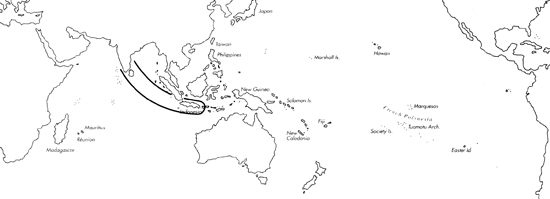Range: S. India and Sri Lanka to Indonesia (Java, Bali).
Description: Medium-sized to large, moderately solid to solid; relative weight of similarly sized specimens may vary by 40 %. Last whorl ventricosely conical to ovate or slightly pyriform; outline convex at adapical third, less so below, and straight to slightly concave at base. Shoulder subangulate to angulate. Spire of low to moderate height, outline concave to nearly straight. Larval shell with a maximum diameter of 0.8-0.9 mm. First 3-6 postnuclear whorls tuberculate. Teleoconch sutural ramps flat to slightly concave, with 1-2 increasing to 6-12 (or more) weak spiral grooves. Last whorl with variably prominent spiral ribs near base; sometimes additional spiral striae from base to shoulder.
| Shell Morphometry | ||
|---|---|---|
| L | 40-84 mm | |
| RW | 0.16-0.50 g/mm (L 40-76 mm) | |
| (L 40-76 mm) | ||
| RD | 0.56-0.68 | |
| PMD | 0.72-0.85 | |
| RSH | 0.11-0.15 | |
Ground colour white to bluish grey, with axial blue streaks or flames on last whorl. Last whorl with a fine brown to violet- brown reticulate pattern, forming many small rhomboid and tentlike ground colour markings and sparse larger tents. Yellowish brown to brown blotches usually grouped in 2 or occasionally 3-4 spiral bands, interspersed with broad dark brown axial lines and sometimes also with finer spiral lines. Apex pinkish orange. Postnuclear sutural ramps matching last whorl in colour pattern; pattern often only of marginal dots in early whorls. Aperture white, occasionally bluish-white or cream deep within.
Periostracum yellowish brown, thin, translucent, smooth.
Foot pale tan, sparsely mottled with brown; anterior side orangish pink. Siphon white, grading to red distally, with a rather broad black ring centrally (Kohn, unpubl. observ.).
Habitat and Habits: Shallow water to about 50 m; on coral reefs, often beneath coral boulders.
Discussion: C. abbas resembles C. canonicus, C. textile and C. dalli. For comparison with C. textile, see the Discussion of that species; for the distinctions from C. dalli see the Discussion of that species in Vol. 2. C. canonicus can be distinguished by its more straight-sided and usually conoid-cylindrical last whorl, its pink aperture, and by the small round instead of rhomboid markings of the last whorl pattern. In addition, C. canonicus lacks prominent marginal dots in its early postnuclear whorls.

C. abbas range map
This section contains verbatim reproductions of the accounts of 316 species of Conus from the Indo-Pacific region, from Manual of the Living Conidae, by Röckel, Korn and Kohn (1995). They are reproduced with the kind permission of the present publisher, Conchbooks.
All plates and figures referred to in the text are also in Röckel, Korn & Kohn, 1995. Manual of the Living Conidae Vol. 1: Indo-Pacific Region.
The range maps have been modified so that each species account has it own map, rather than one map that showed the ranges of several species in the original work. This was necessary because each species account is on a separate page on the website and not confined to the order of accounts in the book.